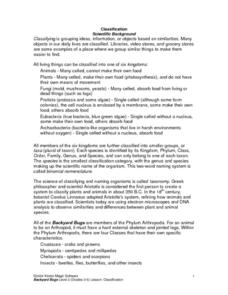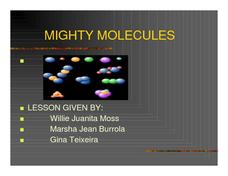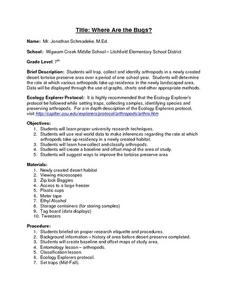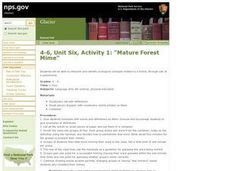Curated OER
How Mutations Lead to Changes in Cell Structure and Function
Learners investigate how mutations lead to changes in cell structure and function. They construct an oligonucleotide, identify a protein sequence, design a step-by-step mechanism of how they think cells repair damaged DNA, and prepare...
Curated OER
An Introduction to Microbes and Microbes Are Everywhere
Seventh graders define the term microbe. They identify the five main groups of microbes. Students give examples of ways in which microbes have impacted or currently impact human life. They create a hypotheses for where they expect to...
Curated OER
What is the Rock Cycle and Its Processes?
Geology beginners examine three different rock samples and determine their origin by their characteristics. By making and recording observations, they become familiar with features of igneous, metamorphic, and sedimentary rock types....
Curated OER
Garden In a Glove
Students investigate the concept of seeds and how they can germinate. They obtain seeds and isolate them in a rubber glove before transplanting them into the ground. The lesson includes a graphic organizer for observations or information.
Curated OER
Backyard Bugs
Explore the concept of scientific classification and the similarities and differences between plant and animal species. Your class will participate in hands-on activities by investigating dichotomous keys and classifying their shoes. To...
Curated OER
Mighty Molecules
Students examine a PowerPoint production on molecules. Then they construct their own molecule and define what an atom, molecule, and matter is. They make a H2, HCI, and an H2O molecule. Finally, a drawing to accompany the actual model is...
Curated OER
Invasives and Macroinvertebrates
Students view macroinvertebrates, or discuss previous collection activity. They graph data on macroinvertebrates in the Hudson River. Students discuss the relationship between habitat, environmental changes, and invertebrate diversity or...
Curated OER
Flour Beetle
Students observe the life cycle of the common flour beetle and make observations of its life stages. They also design and implement an investigation on food preference for the beetle and record data over a period of several months....
Curated OER
Where Are the Bugs?
Students trap, collect and identify arthropods in a newly created desert tortoise preserve area over a period of one school year. They determine the rate at which various arthropods take up residence in the newly landscaped area. Data is...
Curated OER
Circulatory System
In this health worksheet, students examine the human body and make mental connections to the target function highlighted in the sheet.
Curated OER
Innovative Inventions
Help your scholars get a grasp on the chronology of the Industrial Revolution with this "Innovative Inventions" worksheet. They discover what year various items were invented, and then create a timeline placing each invention and...
Biology Corner
Cell Theory Rap
All that this will link you to is a rap about cell theory and organelles. Use it as an example for a creative assignment in your biology class. Divide the class into groups and assign them a topic for which they write and perform a skit,...
Curated OER
Special Terms Assessment
In this following directions worksheet, 3rd graders do the action indicated in each of eight sentences. Students circle four items, put an x on two items. They draw a box around one item, and draw an arrow from one item to the next.
Curated OER
Inventions 2: The Impact
Students explore innovators and inventions. For this technology lesson, students investigate the issues inventors face as they tackle new technology. Students design their own realistic needs-based invention.
Curated OER
Advanced Critical Reading: Biomimetics
Instruct your class on biomimetics while practicing reading comprehension with this worksheet. Learners read a passage that describes the efforts of scientists, starting with Leonardo da Vinci, to emulate nature to solve issues in...
Curated OER
Seahorse Challenge
In this seahorse facts worksheet, students respond to 9 multiple choice questions that require them to exhibit what they know about seahorses.
Curated OER
Bacteria
Students study the advantages and disadvantages of bacteria. In this bacteria lesson students draw and label the different types of bacteria.
Curated OER
Student Exploration: 3D Eclipse
In this eclipse learning exercise, students complete a hands on activity where they simulate an eclipse and answer short answer questions about it. Students complete 19 questions.
Curated OER
Chemosynthesis for the Classroom
Explorers set up Windogradsky columns with local mud so that they can culture microorganisms. After three and six weeks they make observations of the mud and the organisms growing in it. In this way they observe succession and relate...
Curated OER
Human Excretion: Living Environment
A solid review of the excretion system that presents diagrams and asks learners to name the labelled parts or to identify which parts perform the particular jobs stated.
Curated OER
F.B.I.
Learners create a worm bin full of fruit and vegetable scraps wit paper and observe what happens over time. In this decomposers lesson plan, students observe that the fruit and vegetable scraps become new soil.
Curated OER
Mature Forest Mime
Young scholars come to understand vocabulary words through pantomime. In this vocabulary lesson plan, students first review several vocabulary words and their meaning, then they work in groups to pantomime the definitions.
Curated OER
Antonyms 1
Explore antonyms! There are 10 multiple-choice questions here, and learners must choose the answer that represents the opposite of the word in capital letters. Example words include buoyant, urban, and volatile.
Curated OER
"A Sound of Thunder" Vocabulary in Context
Ray Bradbury does it again, providing a story full of symbolism and interest. After your class reads "A Sound of Thunder" and studies the difficult vocabulary, quiz them with this sheet. Example words include aurora, expendable, and...
Other popular searches
- Parts of a Microscope
- Compound Microscopes
- Label Compound Microscope
- Dissection Microscopes
- Microscope Cheek Cells
- Digital Microscope
- Microscope Lab
- Biology Lab Microscopes
- Scanning Electron Microscopes
- Cheek Cells and Microscopes
- Lesson Plan on Microscopes
- Lenses and Microscopes

























